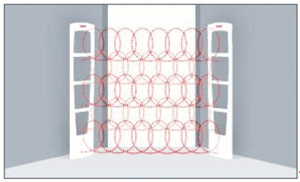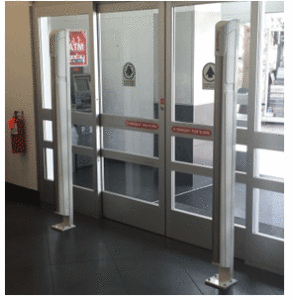 My grandparents owned a small hardware store back in the late 1950s. Back then, when my grandpa left at 5pm, he simply locked the back door, gathered his belongings and left, locking the double glass front door behind him with nothing more than a standard lock that you’d find on any home at the time. The front of the store was nothing but glass. He had cash and at least $100k worth of merchandise on the shelves. Wouldn’t it be nice if things could go back to the way they were back then? Could you imagine if you left your store this soft nowadays? Burglaries happen, and they happen often. Over the past ten years as a Regional LP manager for my company, I’ve had it happen a total of 12 times. About once a year, or so, someone, somewhere across my region, breaks into one of my stores; or at least tries to do so. We have a lot of things that we implement to prevent this from happening, so when someone is able to breach our perimeter, it’s usually caused by human error.
My grandparents owned a small hardware store back in the late 1950s. Back then, when my grandpa left at 5pm, he simply locked the back door, gathered his belongings and left, locking the double glass front door behind him with nothing more than a standard lock that you’d find on any home at the time. The front of the store was nothing but glass. He had cash and at least $100k worth of merchandise on the shelves. Wouldn’t it be nice if things could go back to the way they were back then? Could you imagine if you left your store this soft nowadays? Burglaries happen, and they happen often. Over the past ten years as a Regional LP manager for my company, I’ve had it happen a total of 12 times. About once a year, or so, someone, somewhere across my region, breaks into one of my stores; or at least tries to do so. We have a lot of things that we implement to prevent this from happening, so when someone is able to breach our perimeter, it’s usually caused by human error.
Hiding in a rack
Out of the 12, six never actually tried to “break in”. They simply just stayed in the store. Closing manager task #1 is to WALK THE SALES FLOOR thoroughly before dismissing the team. Always check the hiding spots, restrooms and fitting room stalls, in addition the warehouse areas. What always struck me about these cases, is the suspect has literally nowhere to go. He’s locked into the store; and during every single case, the suspect was a trapped mouse. This of course, is due to the fire exit bars that are installed and locked once the building is no longer occupied. Most criminals think they can just grab what they want and push out of a fire exit…
Smash and grab
I’ve had two of these during my tenure. Suspect drives a vehicle through the front entrance. It never really works out in the long run though. Of these two, one made it in, but the truck was so heavily damaged, it wouldn’t move. The other didn’t get past the cement bollards in the front. I highly recommend the installation of bollards if you don’t have them. Smash and grabs are a more and more common way to burglarize small businesses. Bollards are a way to quite literally, fight back.
Walk right in
My personal 3 favorite burglaries of all times; which also led to the terminations of three separate managers. I know that closing a store has its own set of challenges and there are plenty of things that need to get done before you go home… setting the alarm and locking the door shouldn’t be the two things that you forget though. Either one, or both has happened and they have usually resulted from a scattered brained manager getting very distracted, or not doing something right on the alarm panel. One just got distracted with a personal phone call that he left the store so quickly that the front doors weren’t locked. There are criminals that check these things often. We see thieves check car door handles to see if the car is locked; well there are some that do the same to businesses.
Rappel down
If you have a skylight(s) it is important to make sure access to your roof is restricted at all times. If not, someone can get up there and steal the copper out of your AC units, or go special forces and rappel down into your store; two very funny stories that you’ll have to read in the next article.
While burglaries are a more common problem that we might think, there are several measures that you can implement to make your store less of a target for these crooks. Whether it’s installing an alarm panel, putting in a roll-down shutter down, or making sure the roof ladder isn’t left accessible and your front doors are actually locked at night. Following some pretty basic steps and using some good old fashioned common sense can help you to avoid the headache and lost money that comes from a burglary.
 It’s not too many industries where I can share two separate stories of a crook falling four stories after trying to steal. This is why I chose Loss Prevention as my career. It’s not the thrill of the chase, or the feeling I get when I close a big case; no, it’s the funny stories I get to tell!
It’s not too many industries where I can share two separate stories of a crook falling four stories after trying to steal. This is why I chose Loss Prevention as my career. It’s not the thrill of the chase, or the feeling I get when I close a big case; no, it’s the funny stories I get to tell! It was 4:30am on a Tuesday morning. My company cell phone pierced through the quiet halls of my house. At first, I didn’t get out of bed; perhaps it was a wrong number. Silence. As I doze back off, I hear the familiar tone once again. Who could be calling me and for what reason at this hour? I let it ring. I hear the chirp of the voicemail. Before I can muster the energy to get out of bed, I hear my personal phone ringing. This one is next to me on the night stand. Something is wrong, I immediately think to myself. When I reach for my phone in the middle of the dark room, eyes still blurry, I see the caller ID. It’s a sheriff’s deputy that I’m good friends with. My heart is in my throat as I answer. “You’re morning crew was just robbed at gunpoint. Get to the store now.”
It was 4:30am on a Tuesday morning. My company cell phone pierced through the quiet halls of my house. At first, I didn’t get out of bed; perhaps it was a wrong number. Silence. As I doze back off, I hear the familiar tone once again. Who could be calling me and for what reason at this hour? I let it ring. I hear the chirp of the voicemail. Before I can muster the energy to get out of bed, I hear my personal phone ringing. This one is next to me on the night stand. Something is wrong, I immediately think to myself. When I reach for my phone in the middle of the dark room, eyes still blurry, I see the caller ID. It’s a sheriff’s deputy that I’m good friends with. My heart is in my throat as I answer. “You’re morning crew was just robbed at gunpoint. Get to the store now.”
 Employee theft continues to rise. In some retail settings it’s surpassed customer theft. There are a variety of reasons for the increase. One of them is that many managers have a hard time believing that “My people would do such a thing”. And because they have a hard time believing it they don’t take steps to combat it.
Employee theft continues to rise. In some retail settings it’s surpassed customer theft. There are a variety of reasons for the increase. One of them is that many managers have a hard time believing that “My people would do such a thing”. And because they have a hard time believing it they don’t take steps to combat it.
 Are you confused about how to stop shoplifters? Many Retailers are. Often I hear something like “I have a CCTV camera system to stop shoplifters”. The reality is that shoplifters couldn’t care less. Cameras are a very tiny deterrent to a shoplifter. They know you do not have the time or payroll dollars to actively watch. And it is easy enough to create a diversion or simply take your merchandise and move to another location in your store that does not have camera coverage.
Are you confused about how to stop shoplifters? Many Retailers are. Often I hear something like “I have a CCTV camera system to stop shoplifters”. The reality is that shoplifters couldn’t care less. Cameras are a very tiny deterrent to a shoplifter. They know you do not have the time or payroll dollars to actively watch. And it is easy enough to create a diversion or simply take your merchandise and move to another location in your store that does not have camera coverage.  EAS is great isn’t it? For the most part, if someone is stealing product “X,” you slap on a quick tag or label and you see a pretty substantial reduction in shrink (for the most part.… Live in the real world). As my LP career has progressed over the years, I’ve seen EAS change drastically. I’ve also seen what retailers apply EAS tags to change as well. Often times, I scratch my head in disbelief at the ideas that come out sometimes and others, I pull my hair out because we could have been more proactive with tag placement. I’ve also seen some fantastic ideas from my store teams on some not so standard tagging procedures.
EAS is great isn’t it? For the most part, if someone is stealing product “X,” you slap on a quick tag or label and you see a pretty substantial reduction in shrink (for the most part.… Live in the real world). As my LP career has progressed over the years, I’ve seen EAS change drastically. I’ve also seen what retailers apply EAS tags to change as well. Often times, I scratch my head in disbelief at the ideas that come out sometimes and others, I pull my hair out because we could have been more proactive with tag placement. I’ve also seen some fantastic ideas from my store teams on some not so standard tagging procedures. Everyone I know loves a good “dumb criminal” story. In fact, I can’t go a day without someone (store managers, district managers, executives, family…) asking me to tell a crazy shoplifting story. I have a top 10 list that I usually gravitate towards, but after yesterday, I may have to change it to a top 11.
Everyone I know loves a good “dumb criminal” story. In fact, I can’t go a day without someone (store managers, district managers, executives, family…) asking me to tell a crazy shoplifting story. I have a top 10 list that I usually gravitate towards, but after yesterday, I may have to change it to a top 11. Often overlooked for small businesses is the dire need for a suitable burglar alarm system. I talk about EAS placement and CCTV all the time. Those are rendered absolutely useless is someone busts in through the back door. If your burglar system isn’t up to standards, you run the risk of losing everything.
Often overlooked for small businesses is the dire need for a suitable burglar alarm system. I talk about EAS placement and CCTV all the time. Those are rendered absolutely useless is someone busts in through the back door. If your burglar system isn’t up to standards, you run the risk of losing everything.